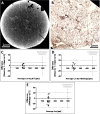Three dimensional imaging of paraffin embedded human lung tissue samples by micro-computed tomography
- PMID: 26030902
- PMCID: PMC4452358
- DOI: 10.1371/journal.pone.0126230
Three dimensional imaging of paraffin embedded human lung tissue samples by micro-computed tomography
Abstract
Background: Understanding the three-dimensional (3-D) micro-architecture of lung tissue can provide insights into the pathology of lung disease. Micro computed tomography (µCT) has previously been used to elucidate lung 3D histology and morphometry in fixed samples that have been stained with contrast agents or air inflated and dried. However, non-destructive microstructural 3D imaging of formalin-fixed paraffin embedded (FFPE) tissues would facilitate retrospective analysis of extensive tissue archives of lung FFPE lung samples with linked clinical data.
Methods: FFPE human lung tissue samples (n = 4) were scanned using a Nikon metrology µCT scanner. Semi-automatic techniques were used to segment the 3D structure of airways and blood vessels. Airspace size (mean linear intercept, Lm) was measured on µCT images and on matched histological sections from the same FFPE samples imaged by light microscopy to validate µCT imaging.
Results: The µCT imaging protocol provided contrast between tissue and paraffin in FFPE samples (15 mm x 7 mm). Resolution (voxel size 6.7 µm) in the reconstructed images was sufficient for semi-automatic image segmentation of airways and blood vessels as well as quantitative airspace analysis. The scans were also used to scout for regions of interest, enabling time-efficient preparation of conventional histological sections. The Lm measurements from µCT images were not significantly different to those from matched histological sections.
Conclusion: We demonstrated how non-destructive imaging of routinely prepared FFPE samples by laboratory µCT can be used to visualize and assess the 3D morphology of the lung including by morphometric analysis.
Conflict of interest statement
Figures





References
-
- Hasegawa M, Nasuhara Y, Onodera Y, Makita H, Nagai K, Fuke S, et al. (2006) Airflow limitation and airway dimensions in chronic obstructive pulmonary disease. Am J Respir Crit Care Med 173: 1309–1315. - PubMed
-
- Ranga V, Kleinerman J (1978) Structure and function of small airways in health and disease. Arch Pathol Lab Med 102: 609–617. - PubMed
Publication types
MeSH terms
Substances
Grants and funding
LinkOut - more resources
Full Text Sources
Other Literature Sources

